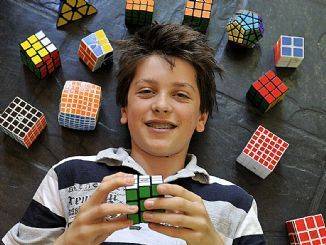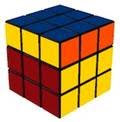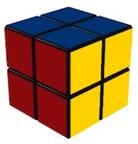Rubik’s cube in ten seconds or less
by Burkard Polster and Marty Ross
The Age, 2 August 2010

In the beginning, nobody could solve The Cube. Not even Ernő Rubik, the Cube's inventor.
Today, 36 years on, expert speedcubers can solve a scrambled cube in under ten seconds. This includes 14-year-old champion Feliks Zemdegs. Feliks, from Melbourne, has just set a new world record, solving five randomly scrambled cubes in an average time of 8.52 seconds. You can watch Feliks performing this remarkable feat here.
Other people are not so quick. For lots, the clock is still ticking ...
Most who have played with the cube can correctly arrange the top layer without assistance. Determining how to get further is not easy, though many people have solved the cube on their own. (Yes, your Maths Masters included).
Millions of others have learned to solve the cube by following one of the readymade recipes, available in books and on the internet: here is such a recipe. The key to these strategies is the use of specific combinations of cube twists. (By a twist we mean a rotation of one of the six faces of the cube, by either 90, 180 or 270 degrees). Each twist combination has the effect of moving a few targeted pieces, while leaving the previous work undisturbed. For example, one nice method begins by correctly arranging the top layer, and then uses just five twist combinations, over and over, to unscramble everything else.
These strategies are popular because they are not too difficult to follow. However, faced with a troublesome cube, they can easily require more than a hundred twists in total. Still, with practice, you should be able to reliably solve a cube in about a minute.
Feliks does not use such beginner's methods. The method Feliks uses requires memorising more than a hundred separate combinations. With all these combinations at hand, Feliks can usually solve a cube with about 60 twists. Together with streamlined cube-handling, custom-built cubes, a good dose of talent, and LOTS of practice, Feliks can usually unscramble a cube in less than ten seconds. But speedcubing is clearly not for the faint-hearted.
How much faster could Feliks become? Conceivably, that might depend upon him using even more combinations, to lower the total number of moves required. So, how far is an average of 60 twists from being the best possible? Let's investigate.
There are 43,252,003,274,489,856,000 different scrambled states of the cube. How many of these take just one twist to solve?

Working backwards from a solved cube, we can choose to turn any one of 6 faces, and the chosen face can be twisted either 90, 180, or 270 degrees. That gives a total of 6 x 3 = 18 positions that can be solved with one twist.
Starting with one of these 18 positions, let's now make a second twist. There's no value in twisting the same face again, so we are left with 5 x 3 = 15 choices for this second twist. Together with the first twist, this shows that no more than 18 x 15 = 270 new positions of the cube can be solved with two twists. (It will actually be lower than 270 new solved positions, because some of the 270 two-twist combinations will simply be alternative methods for solving the same jumbled cube). Including a third twist, we find that that there are at most 18 x 15 x 15 new positions that can solved with three twists. And so on.
Adding up these numbers, corresponding to combinations of up to 15 twists, we arrive at a monster number just below the total number of cube positions we gave above. This shows that there are definitely scrambled cubes requiring no fewer than 16 twists to unscramble.
In fact, using more sophisticated arguments and some serious number-crunching, it has been shown that there are scrambled cubes requiring at least 20 twists to be unscrambled. However, in 2008 computer scientist Tom Rokicki proved that any scrambled cube can somehow be solved with no more than 22 twists; Tom also calculated that, on average, 18 twists will suffice to unscramble a cube.
Comparing these numbers to Feliks's average of 60, there is seemingly plenty of room for improvement. But is that really true? Memorise zillions of combinations? Practise the instant recognition of a gazillion different positions, each requiring a different combination? Only time will tell what is really possible here, but shaving more than a second or two off of Feliks's record would be an incredible feat. Will the five second barrier ever be broken?
Acknowledgements: We would like to thank Feliks Zemdegs and Tom Rokicki for their kind assistance with the writing of this column.
Puzzle to Ponder: Feel free to suggest solutions in the comments section. Please also email us if you wish to be added to our email list.

The 2x2x2 Rubik's cube has a total of 3,674,160 scrambled positions. Now look again at our twist-counting calculation above. Can you use a similar calculation to guarantee a minimum number of twists that a stubborn 2x2x2 cube would require?
Burkard Polster teaches mathematics at Monash and is the university's resident mathemagician, mathematical juggler, origami expert, bubble-master, shoelace charmer, and Count von Count impersonator.
Marty Ross is a mathematical nomad. His hobby is smashing calculators with a hammer.
www.qedcat.com
Copyright 2004-∞ ![]() All rights reserved.
All rights reserved.